Overview
This article delves into the diverse range of preparative HPLC columns that are pivotal for advancing pharmaceutical applications. These columns are crucial for achieving precise compound separation and analysis, underscoring their significance in the field. Leading manufacturers such as JM Science, Agilent, and Waters provide these advanced solutions, designed with cutting-edge technologies and customizable features. Such innovations markedly enhance laboratory efficiency and reliability in pharmaceutical research and development.
By employing these high-quality instruments, laboratories can optimize their workflows, ensuring accurate and reproducible results. The integration of advanced technologies into these columns not only boosts performance but also aligns with the evolving demands of pharmaceutical research. As a result, researchers can achieve their objectives with greater confidence, knowing they are supported by reliable tools tailored to their specific needs.
In summary, the availability of sophisticated preparative HPLC columns represents a significant advancement in pharmaceutical laboratories. By investing in these essential instruments, organizations can enhance their research capabilities, ultimately leading to more effective drug development and analysis.
Introduction
The pharmaceutical industry is in a state of constant evolution, driven by an unprecedented demand for precision and efficiency in analytical processes. At the forefront of this transformation are High-Performance Liquid Chromatography (HPLC) columns, which are essential for enhancing the reliability and accuracy of compound separation and analysis. As laboratories strive to optimize their methodologies, a critical question emerges: which HPLC columns are best equipped to meet the diverse and rigorous demands of pharmaceutical applications? This article delves into seven exceptional prep HPLC columns that not only address these challenges but also elevate laboratory performance to unprecedented levels.
JM Science HPLC Columns: Precision for Reliable Results
JM Science offers an extensive range of HPLC products, meticulously designed to ensure the accuracy and dependability essential for pharmaceutical applications. These products meet the rigorous demands of and analysis, enabling facilities to maintain high standards in quality control and research. By integrating premium materials with cutting-edge manufacturing methods, JM Science significantly enhances the performance reliability of these products, making them a preferred choice among research facility managers.
Practical applications demonstrate how JM Science's high-performance liquid chromatography products have improved laboratory precision, with users reporting enhanced accuracy in their analyses. Furthermore, JM Science supports its clients with a wealth of resources, including application libraries and instructional videos, empowering users to optimize their chromatography systems effectively. This unwavering commitment to quality and support underscores the reliability of JM Science chromatography systems in achieving accurate results in pharmaceutical research and development.
For more information on how JM Science can elevate your laboratory's performance, explore our product specifications and resources today.
Thermo Fisher Scientific Preparative HPLC Columns: Versatile Solutions for Laboratories
JM Science Inc.'s prep HPLC columns exemplify versatility across a broad spectrum of applications, showcasing a diverse selection of high-performance liquid chromatography solutions. With an impressive variety of , these systems enable precise customization to fulfill specific partitioning needs, accommodating both small molecules and larger biomolecules.
The robust design of JM Science's high-performance liquid chromatography tubes guarantees longevity and dependability, making them ideal for high-throughput research settings. Their construction facilitates seamless transitions between analytical and preparative scales, allowing for the effective prep HPLC columns while maintaining exceptional performance without compromise.
This flexibility is crucial for pharmaceutical laboratories, where the demand for efficient and reliable techniques for partitioning is paramount.
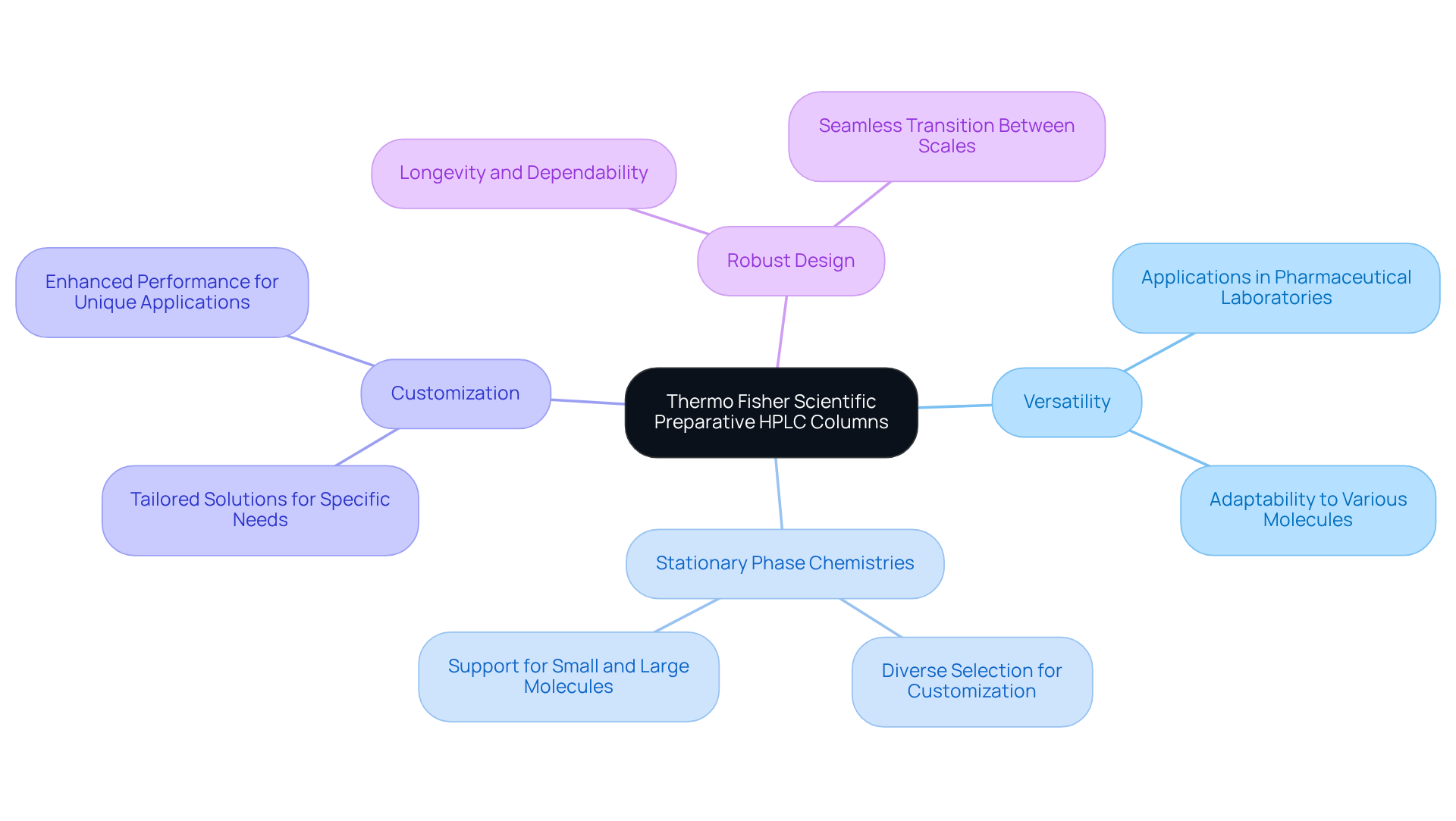
Agilent Technologies HPLC Columns: High Efficiency for Analytical Excellence
Agilent Technologies stands at the forefront of high-efficiency HPLC products, renowned for delivering exceptional analytical performance. These products are meticulously developed using advanced technologies that significantly enhance separation efficiency, resolution, and speed. By employing high-quality silica and innovative bonding techniques, Agilent ensures that its products produce consistent results across a wide range of applications. Laboratories that utilize Agilent products can anticipate enhanced sensitivity and reproducibility, making them indispensable for critical pharmaceutical analyses where precision is paramount. Trust in Agilent Technologies to .
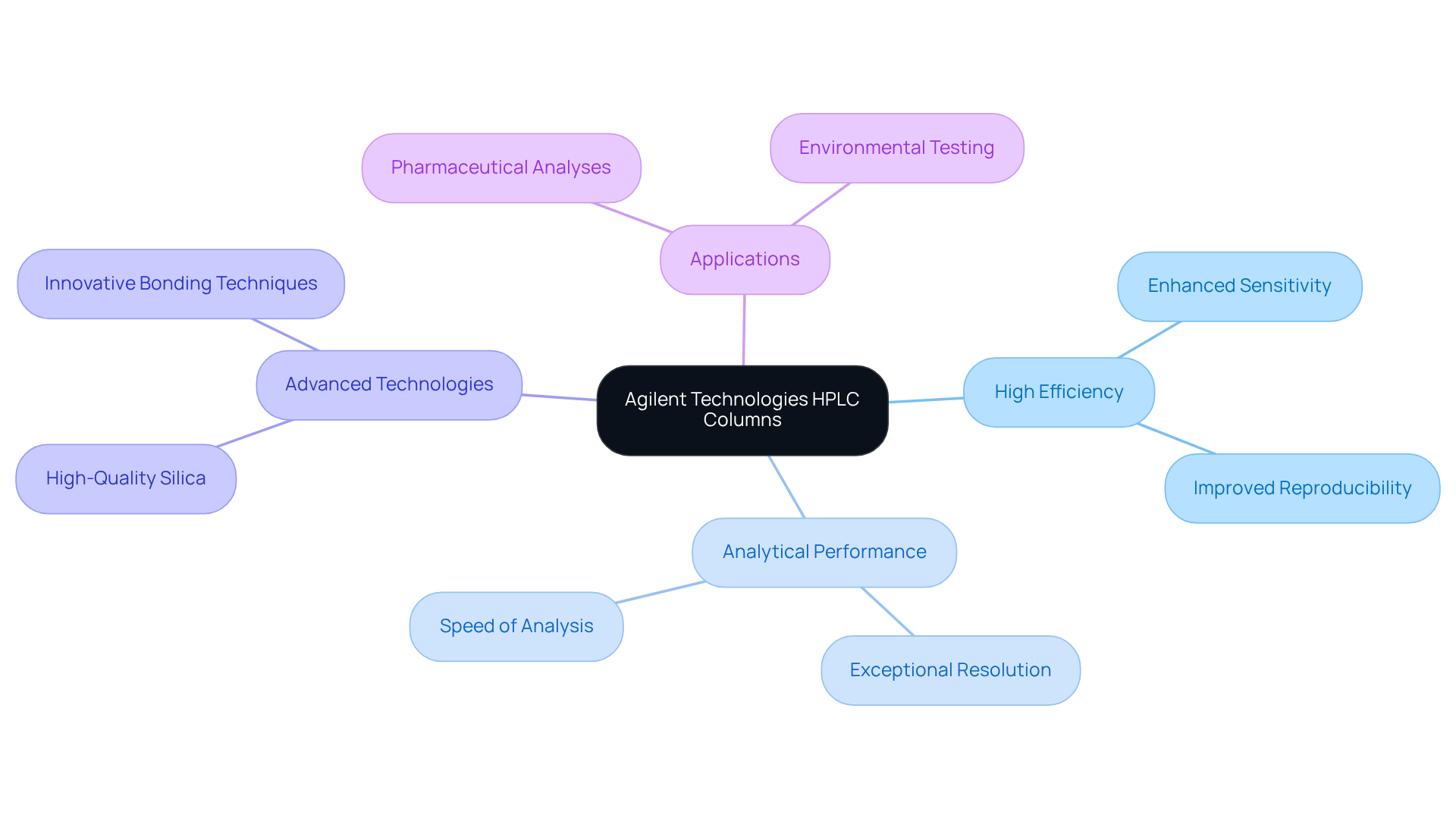
Kromasil HPLC Columns: Tailored Solutions for Method Development
Kromasil HPLC devices are expertly engineered to prep HPLC columns for method development across a multitude of analytical applications, particularly in the pharmaceutical sector where precision is paramount. Their customizable stationary phases enable researchers to prep HPLC columns and optimize separation conditions, delivering tailored solutions that satisfy specific analytical requirements. This adaptability is indispensable, enabling the to achieve optimal results that are critical in pharmaceutical research. Kromasil's unwavering commitment to quality guarantees that their products deliver high performance, even in demanding environments.
As the industry evolves, the trend toward customizable stationary phases in prep HPLC columns is increasingly prominent, enabling laboratories to innovate and validate new methodologies with enhanced efficiency. Researchers have observed the substantial impact of these customizable options, highlighting their significance in advancing analytical capabilities and supporting rigorous pharmaceutical applications.
JM Science Inc. plays a pivotal role in supplying these high-quality HPLC components, offering a comprehensive range of premium HPLC tubes, including Shodex, CapcellPak, and Reprosil, along with essential accessories, ensuring that research facilities are equipped with the finest tools for their investigative needs.
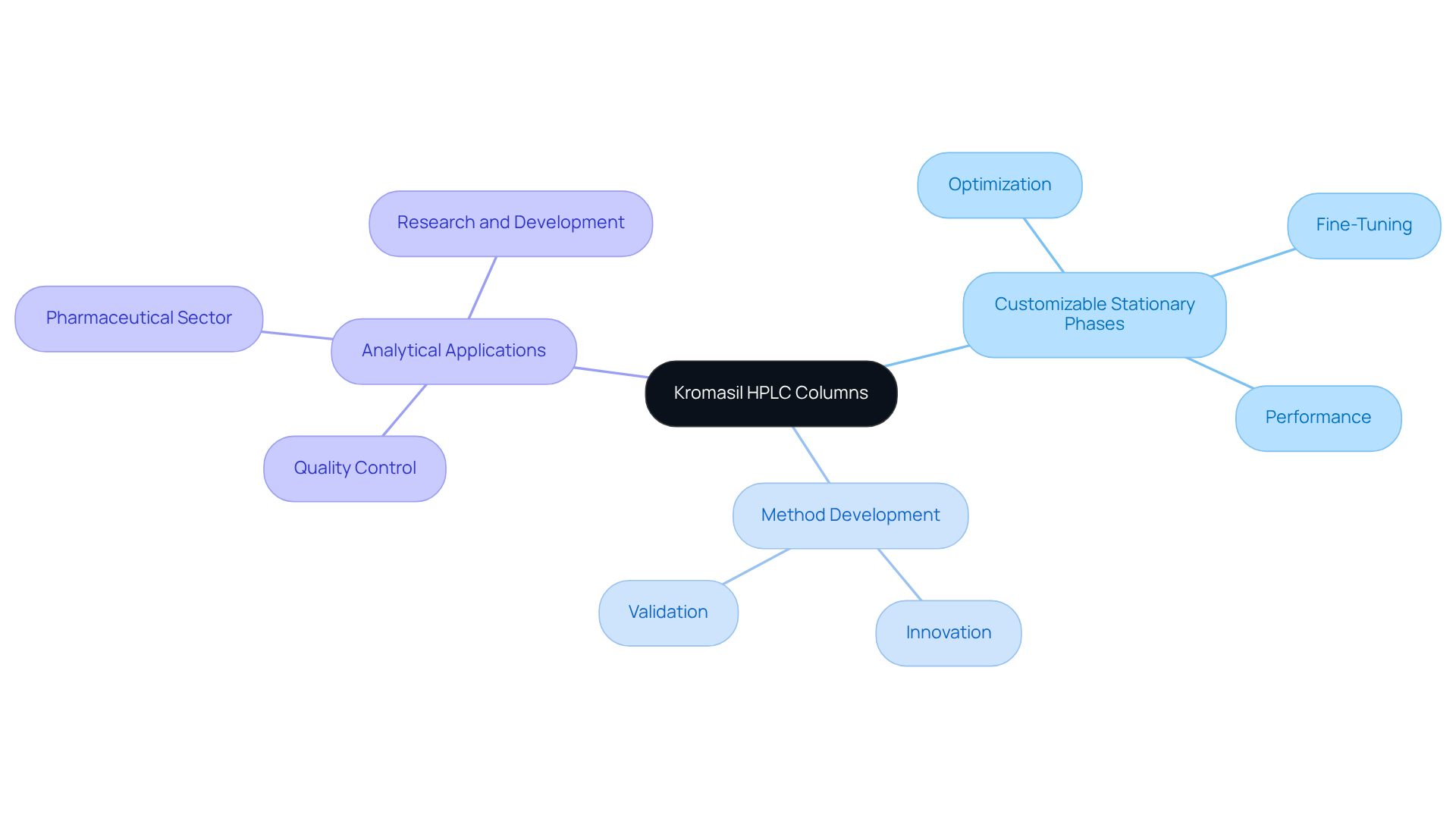
Biotage Flash Chromatography Columns: Accelerating Peptide Purification
Biotage flash chromatography devices are pivotal in enhancing peptide purification, making them essential for laboratories focused on peptide synthesis. These advanced instruments leverage cutting-edge technology to achieve high flow rates and exceptional purification, thereby significantly reducing processing times. Their ability to handle larger sample loads per injection allows researchers to boost productivity and streamline workflows for downstream applications.
A comparative analysis reveals that Biotage's high-performance devices provide superior separation and purity, utilizing 50% less solvent and 60% less silica than conventional alternatives. Operating globally with a workforce of 700 employees, Biotage serves over 80 countries, underscoring its commitment to innovation in peptide purification technology. As Bob Bickler from Biotage articulates, "To get the best compound purity and yield, good peak resolution is required." This statement highlights the critical importance of employing high-performance structures to achieve optimal results effectively.
Moreover, the integration of solid phase extraction (SPE) is emerging as a strategic approach for peptide library clean-up, further augmenting the effectiveness of purification processes. This evolution in methodology not only enhances the but also positions Biotage at the forefront of advancements in the field.
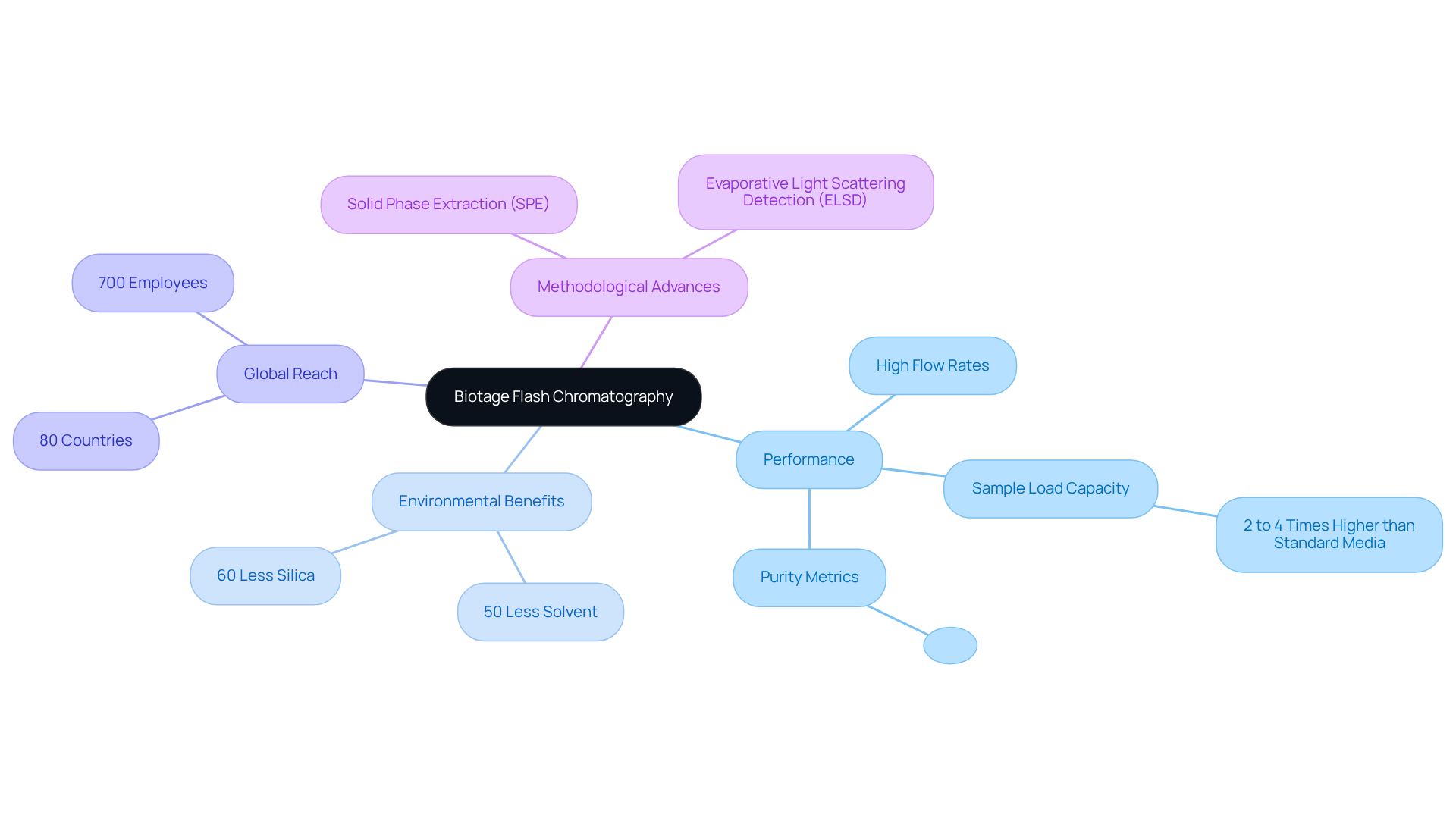
Waters HPLC Columns: Comprehensive Solutions for Diverse Applications
Waters HPLC tubes deliver customized solutions tailored to the diverse needs of research facilities, featuring a broad array of types, including reversed-phase, normal-phase, and size exclusion. This extensive selection empowers laboratories to optimize method development and validation processes effectively. Engineered for high performance, Waters products guarantee reliable results across various applications, such as pharmaceutical analysis and environmental testing. For instance, the Zorbax Eclipse Plus C18 device is renowned for its exceptional peak shapes, which are crucial for precise quantification and identification in drug analysis. Furthermore, the Acquity UPLC devices, capable of operating at pressures up to 15,000 psi, significantly enhance throughput and efficiency, making them ideal for high-resolution applications.
Recent trends highlight a growing preference for smaller particle sizes and hydrophilic interaction chromatography (HILIC), reflecting the evolving landscape of analytical techniques. Specifically, 18% of users now utilize 5-µm particles, contributing to improved sensitivity and reproducibility. Additionally, the Grace Vydac 201TP C18 chromatography column is specialized for peptide and protein separations, offering high resolution that is crucial for detailed biomolecule analysis. As laboratories increasingly adopt these advanced systems, they benefit from enhanced sensitivity and reproducibility, which are essential for meeting stringent regulatory standards in pharmaceutical development and environmental safety evaluations.
Significantly, the typical yearly spending plan for prepacked analytical high-performance liquid chromatography tubes is approximately $2,890, while guard tubes average around $1,650, underscoring important financial considerations for lab managers. Moreover, the Jasco X-LC® C18 column, designed for extra-low dispersion, enhances sensitivity and resolution for high-throughput systems. With a substantial percentage of respondents reporting , advancements in technology are evident, making these investments increasingly attractive for long-term use.
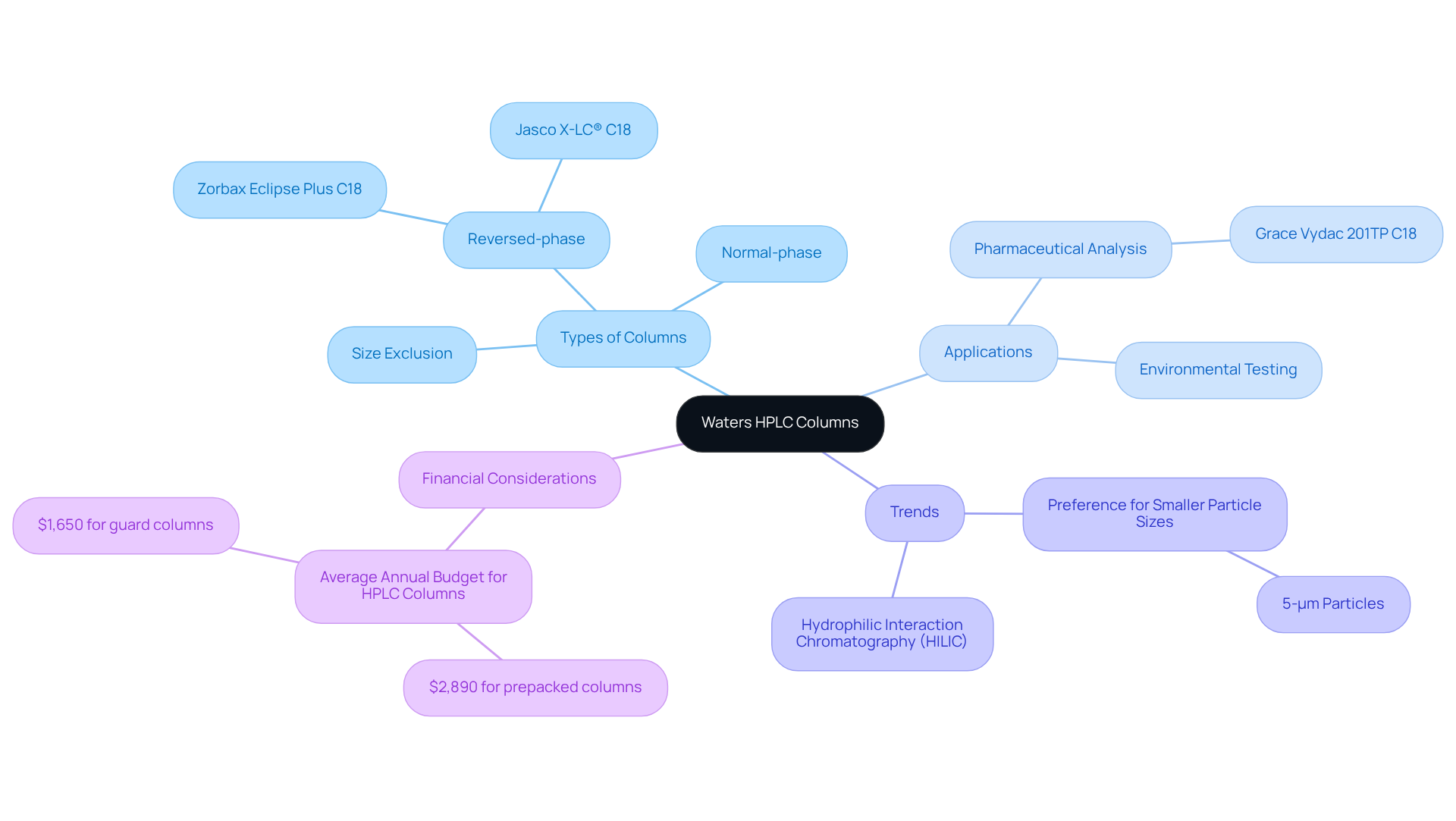
Current Trends in HPLC Column Usage: Insights from Chromatography Online
Recent insights from Chromatography Online reveal several key trends in HPLC equipment usage that are crucial for laboratories aiming to maintain a competitive edge in analytical chemistry. A growing preference for superficially porous and monodisperse particles has emerged, significantly enhancing both resolution and speed in analytical processes. Alongside this, the focus on sustainability is intensifying, as laboratories increasingly seek eco-friendly solutions that effectively reduce solvent consumption. Moreover, the trend towards shorter structures for quicker separations is gaining momentum, enhancing efficiency while simultaneously minimizing waste.
Market forecasts indicate that the global high-performance liquid chromatography market is anticipated to reach USD 5729.3 million by 2025, expanding at a CAGR of 16.20%. Staying informed about these trends is in a rapidly evolving landscape.
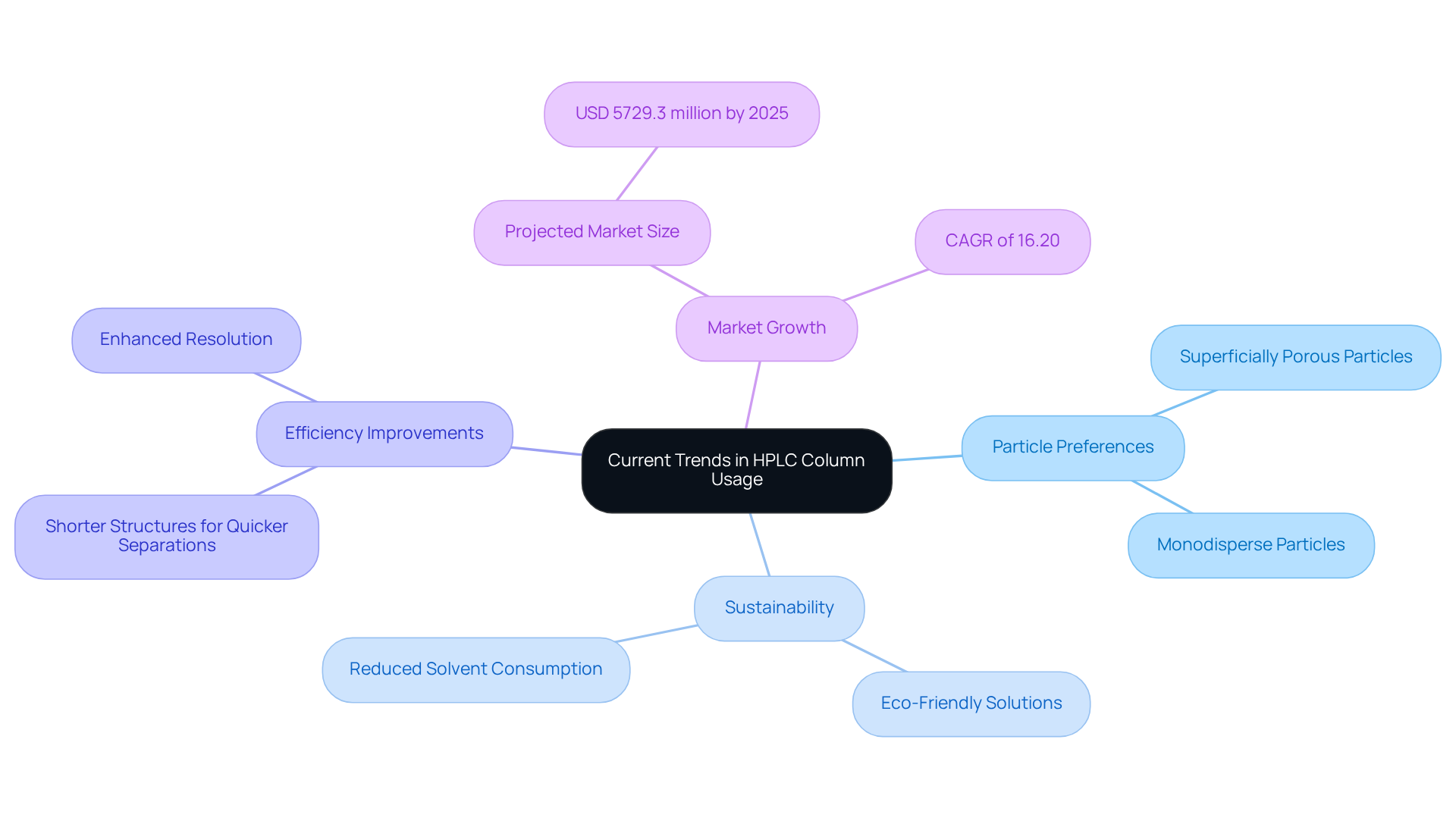
ResearchGate Insights: Understanding Preparative vs. Analytical HPLC Columns
ResearchGate provides essential insights into the distinctions between preparative and analytical HPLC types.
Analytical tubes, typically smaller in diameter (4.6 mm), are engineered for high efficiency, concentrating on the separation of individual components for qualitative analysis. They employ particle sizes ranging from 3-5 μm and operate at flow rates between 0.1-10 ml/min. This design makes them particularly suitable for applications such as drug metabolite profiling, where the identification of trace metabolites is critical.
Conversely, prep HPLC columns are larger, with diameters spanning from 50-200 mm, and are designed to accommodate higher sample loads, facilitating the purification of compounds for subsequent use. These structures utilize larger particle sizes, generally ranging from 20-50 μm, and function at flow rates of 10-200 ml/min. A notable application is the use of prep HPLC columns in the purification of peptide intermediates, where larger injection volumes yield significant amounts of pure compounds. For instance, the MDM2 protein purification achieved 14 mg yields using a semi-preparative C18 support under a 60°C gradient elution.
Furthermore, the average yearly budget for prepacked analytical columns is approximately $2890, a considerable factor for research facilities. Understanding these distinctions is vital for laboratories aiming to in both analytical and preparative contexts.
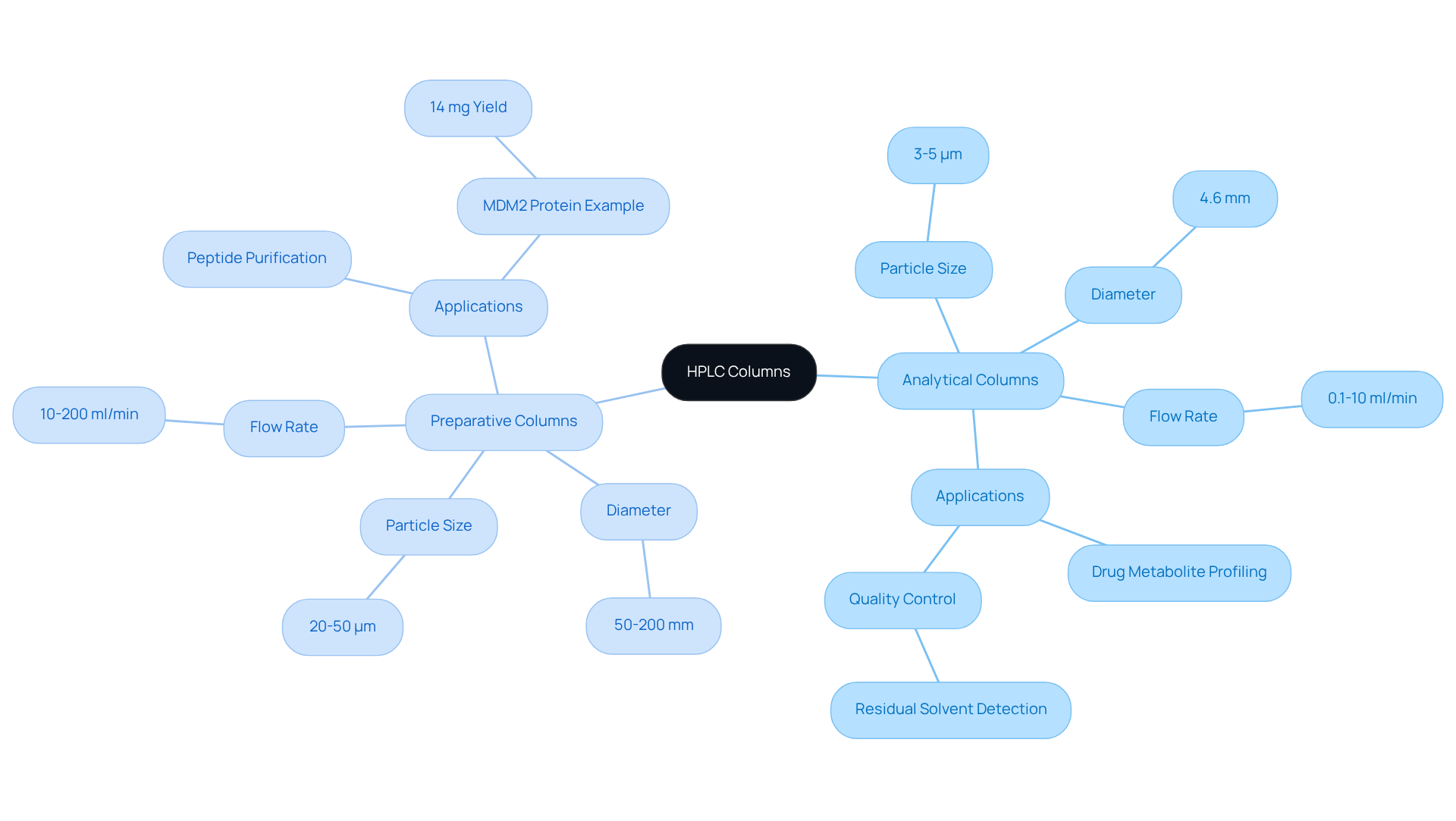
ScienceDirect Resources: Best Practices for Preparative Liquid Chromatography
ScienceDirect provides comprehensive resources on best practices for preparative liquid chromatography, emphasizing the critical role of in enhancing the performance of prep HPLC columns. JM Science Inc. offers an extensive selection of high-quality chromatography columns, including Shodex, CapcellPak, and Reprosil, which are essential for achieving optimal efficiency in laboratory settings. Additionally, JM Science supplies titrators and detectors that further enhance their chromatography solutions.
Research indicates that adjusting flow rates can significantly affect performance, with optimal rates typically ranging from 0.25 to 0.50 mL/min for superficially porous particles (SPPs). It is vital to maintain consistent temperature and pressure conditions for reproducibility, as fluctuations can lead to variations in retention factors and selectivity. Regular calibration of equipment and method validation are recommended to ensure reliable results.
For example, a recent study demonstrated that optimizing flow rates during isocratic separation improved resolution, achieving a yield of 77% with CBD purity exceeding 99%. By implementing these optimal methods and utilizing JM Science's innovative chromatography solutions, including their titrators and detectors, laboratories can prep HPLC columns to enhance purification processes, resulting in higher yields of desired compounds and improved overall efficiency in pharmaceutical applications.
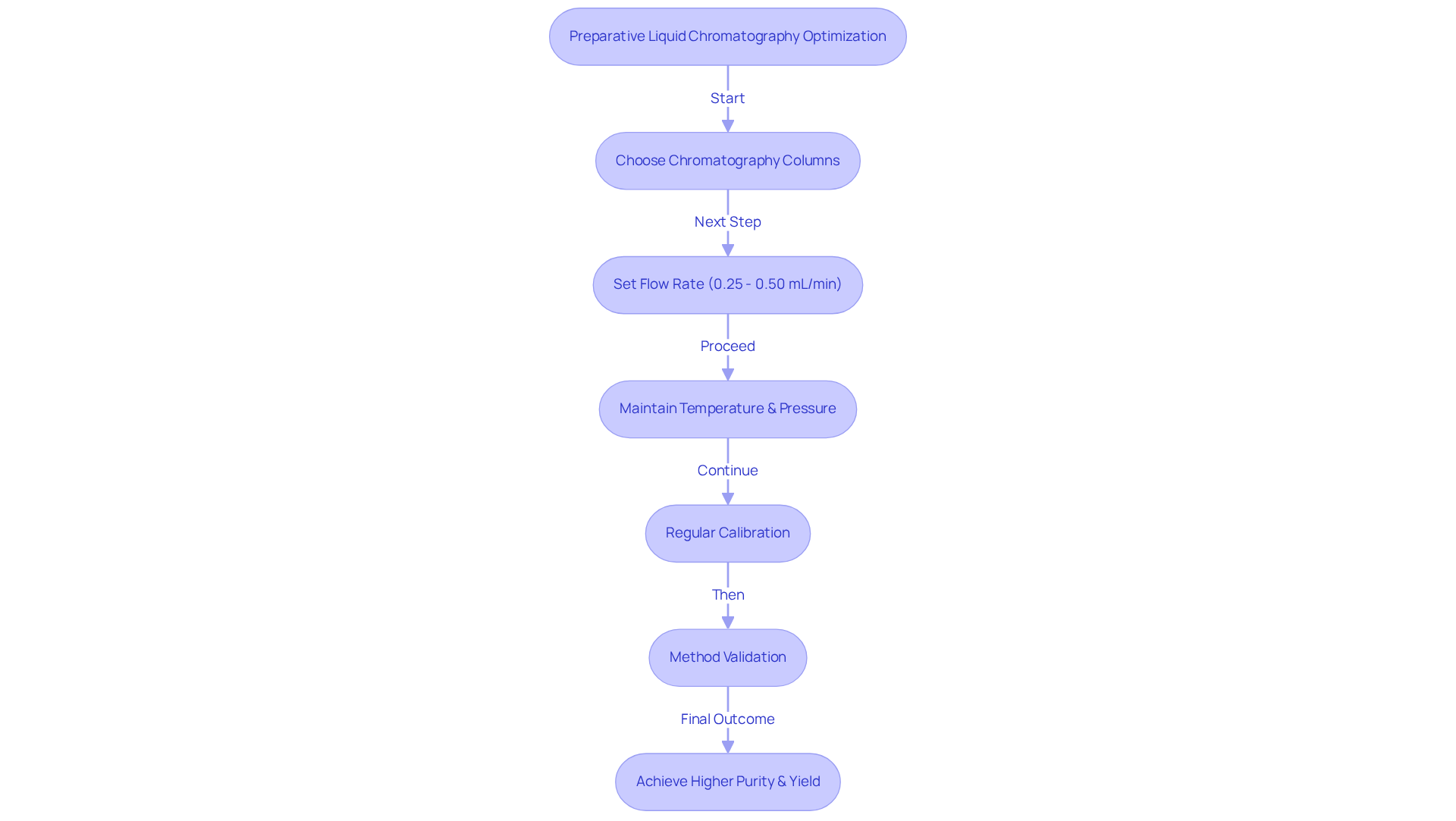
Biotech Fluidics HPLC Column Hardware: Enhancing Chromatography Performance
Biotech Fluidics is at the forefront of chromatography hardware innovation, specifically engineered to enhance performance. Their product line, which includes flowmeters and high-pressure connections, is meticulously designed to minimize dead volume and maintain consistent flow rates. This level of precision is essential for achieving optimal peak shape and resolution during separations.
By investing in high-quality hardware for prep HPLC columns, laboratories can significantly bolster the reliability and efficiency of their HPLC systems. This investment ultimately leads to superior analytical outcomes, reinforcing the importance of in laboratory settings.
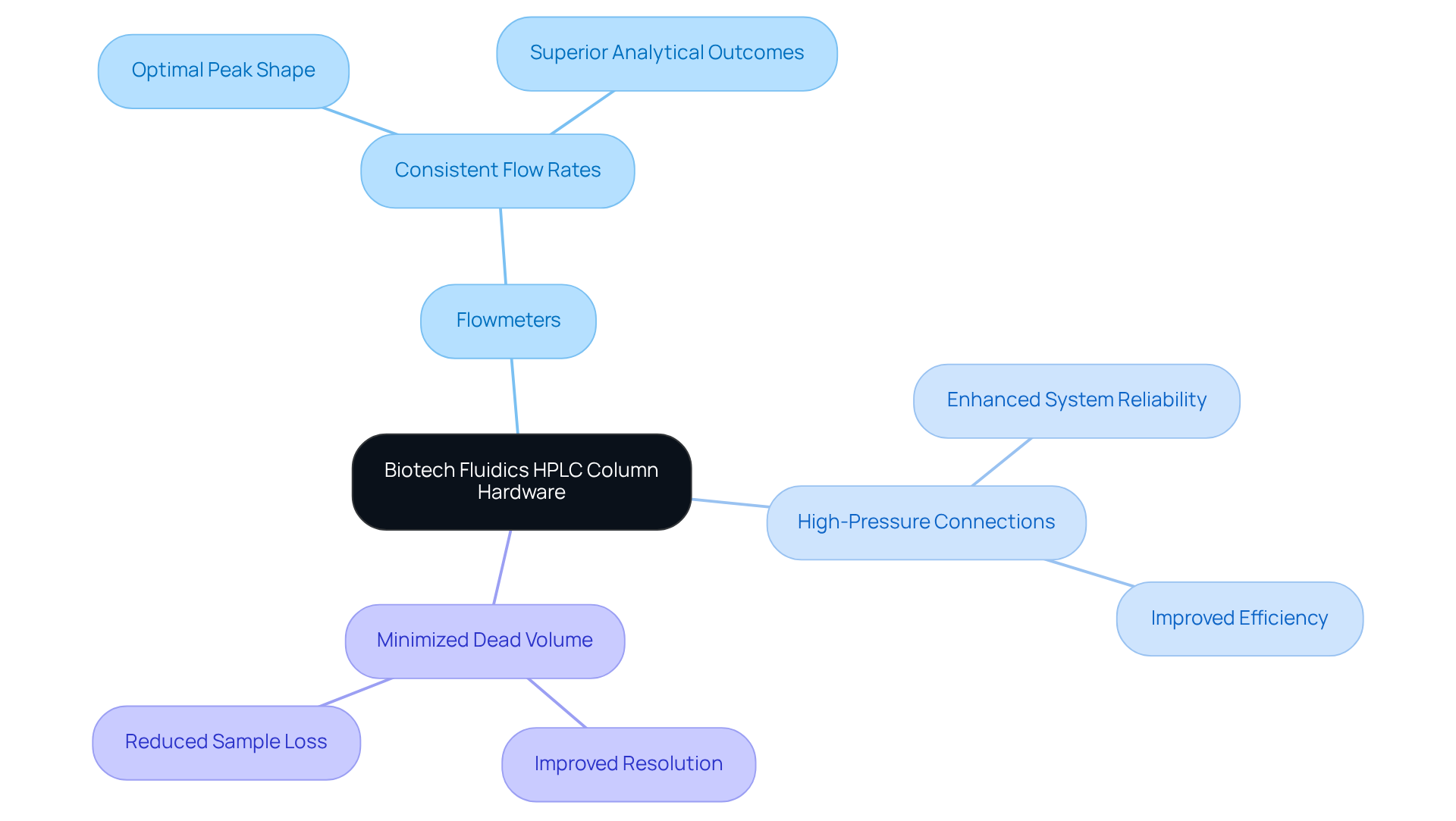
Conclusion
The exploration of high-performance liquid chromatography (HPLC) columns underscores their indispensable role in enhancing pharmaceutical applications. These specialized columns, which include precision products from JM Science and innovative flash chromatography solutions from Biotage, are meticulously designed to meet the rigorous demands of both analytical and preparative processes. The advancements in HPLC technology not only enhance accuracy and efficiency but also empower laboratories to achieve superior results in compound separation and analysis.
Key insights from the article illuminate the versatility and adaptability of various HPLC columns, such as those from Thermo Fisher Scientific and Waters, which cater to a wide array of laboratory needs. The emphasis on customizable solutions, efficiency in method development, and the critical importance of optimizing flow rates highlight the evolution of HPLC systems within the pharmaceutical landscape. Furthermore, the trends identified, including the shift towards environmentally friendly practices and the integration of advanced hardware from companies like Biotech Fluidics, reflect a growing commitment to sustainability and performance enhancement in laboratory settings.
In summary, the advancements and innovations in HPLC column technology are crucial for laboratories striving to maintain a competitive edge in pharmaceutical research and development. By adopting these cutting-edge solutions, laboratories can significantly enhance their analytical capabilities, streamline workflows, and ultimately achieve improved outcomes in drug analysis and purification. Embracing these trends and investing in high-quality HPLC systems will not only elevate laboratory performance but also contribute to the ongoing pursuit of excellence in the pharmaceutical industry.




